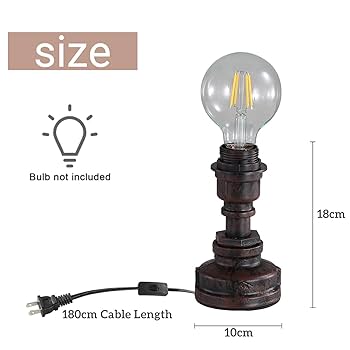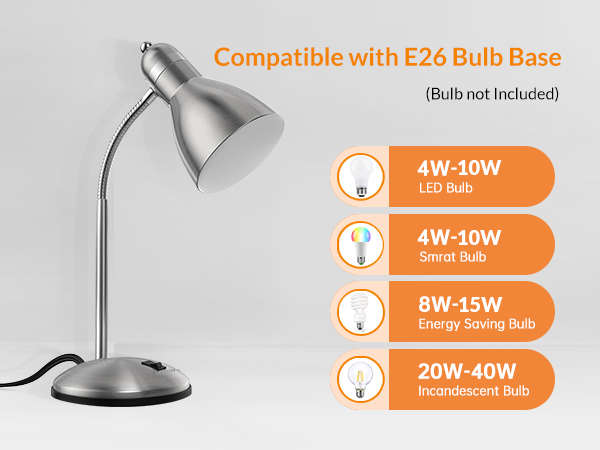Choosing the right size light bulb for your desk lamp might seem simple, but it can make a big difference in how well you see and how comfortable your workspace feels. If you’ve ever struggled with a bulb that’s too bright, too dim, or just won’t fit, you’re not alone.
Getting the perfect bulb size means better lighting, less eye strain, and a more productive environment. Keep reading, and you’ll discover exactly what size light bulb fits your desk lamp and why it matters for your daily tasks.

Credit: www.amazon.com
Choosing The Right Bulb Size
Choosing the right bulb size for your desk lamp matters for both light quality and safety. The correct bulb fits securely and gives the best brightness for your tasks. Picking the wrong size can cause damage or poor lighting.
Standard Bulb Sizes For Desk Lamps
Desk lamps usually use these common bulb sizes:
- E26:The standard medium base, common in many lamps.
- E12:Smaller candelabra base, often in decorative lamps.
- GU10:Twist-and-lock base, found in some modern desk lamps.
Knowing these sizes helps you buy the right bulb easily.
Measuring Your Lamp Socket
Measure the socket diameter with a ruler or tape measure. Check the base type written on the lamp or bulb. This information ensures the bulb fits snugly and works safely.
Proper measurement avoids buying bulbs that won’t fit or function correctly.
Compatibility With Lamp Shades
Choose a bulb size that fits inside your lamp shade comfortably. Bulbs that are too big can touch the shade, causing heat damage. Too small bulbs may not light the area well.
Match the bulb shape and size with the shade for best light spread and safety.
Brightness And Wattage Considerations
Choosing the right brightness and wattage for a desk lamp is crucial. It affects how well you see and your comfort during tasks. The correct light helps reduce eye strain and improves focus. Understanding brightness and wattage helps pick the best bulb for your desk lamp.
Understanding Lumens Vs. Watts
Lumens measure the brightness of a light bulb. Watts measure the energy the bulb uses. Higher lumens mean brighter light. Lower watts mean less energy use. Modern bulbs give more lumens with fewer watts. Focus on lumens for brightness, not watts.
Ideal Brightness Levels For Desk Work
Desk work needs clear, bright light. Aim for 400 to 800 lumens. This level suits reading, writing, and computer use. Too dim light causes eye strain. Too bright light causes glare. Use a lamp with adjustable brightness for flexibility.
Energy Efficiency Tips
- Choose LED bulbs for low energy use and long life.
- Pick bulbs with the right lumen output to avoid waste.
- Use lamps with dimmer switches to control brightness.
- Turn off lamps when not in use to save power.
- Check energy labels to find efficient bulbs.
Types Of Bulbs For Desk Lamps
Choosing the right size light bulb for a desk lamp ensures proper fit and brightness. Common types include E26, E12, and GU10 bulbs. Checking the lamp’s socket size helps pick the perfect bulb for clear, comfortable lighting.
Choosing the right bulb for your desk lamp can affect your work environment. The type of bulb impacts light quality, energy use, and comfort. Let’s explore some common options to help you decide.Incandescent Bulbs
Incandescent bulbs are traditional and affordable. They emit a warm, comforting glow. These bulbs are ideal for tasks that require soft light. They have a short lifespan and consume more energy.Led Bulbs
LED bulbs are energy-efficient and long-lasting. They provide bright, clear light, perfect for detailed work. These bulbs stay cool, preventing heat buildup. They are more expensive initially but save money over time.Cfl Bulbs
CFL bulbs offer a middle ground between incandescent and LED. They use less energy than incandescent and last longer. These bulbs take time to reach full brightness. Their light is softer than LED, suitable for general use.Smart Bulbs
Smart bulbs offer modern convenience. They can be controlled via apps or voice commands. Adjust brightness and color with ease. Smart bulbs are energy-efficient and versatile. They are perfect for tech-savvy users.Color Temperature And Lighting Effects
Choosing the right color temperature for your desk lamp can transform your workspace. It’s not just about brightness; the color of the light affects how you feel and work. Understanding these effects helps you pick the perfect bulb size and type for your needs.
Warm Vs. Cool Light
Warm light has a yellowish hue, usually around 2700K to 3000K. It creates a cozy, relaxing atmosphere, ideal for winding down or reading in the evening.
Cool light, ranging from 4000K to 6500K, looks more like daylight. It feels crisp and energizing, helping you stay alert and focused during work.
Think about what you want from your desk lamp. Do you need calmness or clarity? Your choice of warm or cool light will guide your productivity and comfort.
Impact On Productivity And Mood
Cool light can boost your productivity by mimicking natural daylight, which signals your brain to stay active. It reduces eye strain during long hours of work, especially if your tasks require attention to detail.
On the other hand, warm light helps reduce stress and promotes relaxation. It’s perfect if your desk is also a spot for creative thinking or breaks.
Have you noticed how your energy changes with different lighting? Adjusting your desk lamp’s color temperature can influence your mood and efficiency more than you expect.
Choosing The Right Color Temperature
Consider your daily routine before selecting a bulb. If you work mainly during the day, a cool light bulb around 5000K may be best to keep you sharp.
For evening work or reading, a warm bulb between 2700K and 3000K can protect your eyes and calm your mind.
Many modern bulbs offer adjustable color temperatures. This flexibility lets you switch between warm and cool light depending on the time or task.
What kind of light helps you feel your best at your desk? Testing different temperatures can help you find the perfect fit for your workspace.
Safety And Durability Factors
Choosing the right light bulb for your desk lamp isn’t just about brightness or style. Safety and durability play a huge role in ensuring your workspace remains comfortable and hazard-free. Understanding these factors helps you avoid accidents and saves you money in the long run.
Heat Emission And Fire Safety
Bulbs that produce too much heat can damage your lamp or even start a fire. Incandescent bulbs, for example, tend to run hot and may not be suitable for enclosed desk lamps. LED bulbs emit very little heat, making them a safer choice for most setups.
Have you ever touched a bulb that felt dangerously hot? That’s a clear sign you need to switch to a cooler option. Also, always check your lamp’s maximum wattage rating before buying a bulb to prevent overheating.
Bulb Lifespan Expectations
Bulb lifespan varies widely between types and affects how often you’ll need to replace them. LEDs can last up to 25,000 hours, while traditional incandescent bulbs might only last 1,000 hours. Longer lifespan means fewer interruptions and less waste.
Consider your daily usage: if you use your desk lamp for several hours a day, investing in a bulb with a longer lifespan saves time and hassle. Don’t just focus on upfront cost—think about how often you’ll need replacements.
Choosing Durable Materials
The materials used in both the bulb and lamp affect durability and safety. Bulbs with plastic or shatter-resistant coatings are less likely to break if accidentally dropped. Lamps made from sturdy metals or high-quality plastics stand up better to daily use.
Imagine dropping a fragile glass bulb near your workspace. Not only is it a mess, but it’s also a safety hazard. Opt for bulbs and lamps designed to handle the wear and tear of your environment, especially if you have pets or children nearby.

Credit: www.amazon.com
Special Features To Consider
Choosing the right light bulb for your desk lamp goes beyond size. Special features can improve comfort and functionality. These options make your workspace more adaptable and user-friendly. Consider these features to enhance your lighting experience.
Dimmable Bulbs
Dimmable bulbs let you adjust light intensity. They help reduce eye strain during long work hours. You can create the perfect mood for reading or relaxing. These bulbs work well with compatible dimmer switches.
Adjustable Brightness Settings
Some bulbs come with built-in brightness levels. You can switch settings without extra equipment. This offers convenience and control over your lighting. Ideal for tasks needing varied light, such as writing or sketching.
Smart Controls And Connectivity
Smart bulbs connect to apps or voice assistants. Control brightness and color from your phone or smart device. Set schedules or timers for automatic lighting. Enhances ease and modernizes your desk lamp setup.
Maintenance And Replacement Tips
Maintaining your desk lamp and knowing when to replace the bulb keeps your workspace bright and efficient. Proper care extends the lamp’s life and ensures safe use. Simple steps can prevent damage and improve lighting quality.
When To Replace Your Bulb
Replace the bulb when it flickers or dims. A bulb that no longer lights well wastes energy. Check for dark spots or a burnt smell. If the bulb feels hot quickly, it might be faulty. Use the correct size and wattage to avoid damage.
Cleaning Your Desk Lamp
Turn off and unplug the lamp before cleaning. Use a soft cloth to wipe dust from the bulb and shade. Avoid water or harsh cleaners near electrical parts. Clean regularly to keep light bright and prevent overheating. Dust buildup can reduce the lamp’s lifespan.
Disposal And Recycling
Dispose of old bulbs properly to protect the environment. Fluorescent and LED bulbs need special recycling. Do not throw bulbs in regular trash. Check local recycling programs for safe disposal options. Recycling helps recover materials and reduces waste.

Credit: www.amazon.com
Frequently Asked Questions
What Wattage Bulb Is Best For Desk Lamps?
A 40 to 60-watt bulb is ideal for desk lamps. It provides sufficient brightness without causing glare or excessive heat. LED bulbs with equivalent lumens are energy-efficient alternatives that last longer and save electricity.
Which Bulb Size Fits Most Desk Lamps?
The standard bulb size for most desk lamps is the A19 shape with an E26 base. This size fits commonly used sockets and offers versatile lighting options. Always check your lamp’s specifications for the correct bulb size.
Can I Use Led Bulbs In Desk Lamps?
Yes, LED bulbs are perfect for desk lamps. They use less energy, produce less heat, and last longer than incandescent bulbs. Choose LEDs with a color temperature of 3000K to 4000K for comfortable reading light.
How Bright Should A Desk Lamp Bulb Be?
A desk lamp bulb should emit 450 to 800 lumens for optimal brightness. This range ensures clear visibility for reading or working without straining your eyes. Avoid bulbs that are too dim or overly bright.
Conclusion
Choosing the right light bulb size for your desk lamp matters a lot. It affects how well you see and how comfortable your space feels. Always check your lamp’s label or manual for size limits. A proper bulb brightens your work without glare or strain.
Small details like bulb shape and wattage count too. Take time to pick the best fit. Your eyes will thank you. Bright work, less hassle. Simple steps, better light.





